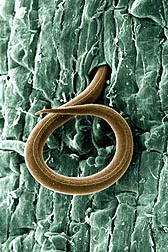
ARS researchers have identified markers for genes that could give upland cotton resistance to root-knot and reniform nematodes, two major pests of the crop. Click the image for more information about
it.
|

|
Newly Found Genes May Lead to Nematode-Resistant Upland Cotton
By Sharon Durham
July 26, 2012 U.S. Department of Agriculture (USDA) researchers have made significant progress in finding genetic resistance to two key cotton pests—the root-knot nematode and the reniform nematode.
Agricultural Research Service (ARS) plant geneticist Johnie Jenkins and his colleagues in the agency's Genetics and Precision Agriculture Research Unit in Mississippi State, Miss., developed genetic markers for the genes responsible for resistance to root-knot nematode in upland cotton. These genes, located on chromosomes 11 and 14, should help breeders develop new varieties of nematode-resistant cotton.
ARS is the USDA's principal intramural scientific research agency, and this research supports the USDA commitment to agricultural sustainability.
Jenkins and his colleagues also found that resistance to reniform nematode in a wild Gossypium barbadense line is governed by more than one gene, and they have identified markers linked to these genes on chromosomes 21 and 18. Their research was published in Theoretical and Applied Genetics. Former post-doctoral researcher Osman Gutierrez (currently a plant geneticist at the ARS Subtropical Horticulture Research Station in Miami, Fla.), was lead author on the paper. Co-authors included agronomist Jack McCarty, molecular geneticist Martin Wubben, and plant physiologist Franklin Callahan, all with ARS at Mississippi State, and retired ARS scientist Forest Robinson at College Station, Texas.
Commercial breeders had steered away from efforts to breed root-knot nematode resistance into upland cotton lines over the years because the resistance was governed by more than one gene and seemed too costly and time-consuming. But the research contributions from Jenkins and his colleagues may change that.
The root-knot nematode has been recognized as a cotton pest for the past 100 years, according to Jenkins. Since the 1930s, scientists have been looking for resistance to nematodes. In the 1960s, ARS started research to find root-knot nematode resistance in cotton. Retired ARS scientist Raymond Shepherd was instrumental in using root-knot nematode resistance in a line of wild cotton from Mexico to develop resistant germplasm.
Read more about this research in the July 2012 issue of Agricultural Research magazine.